
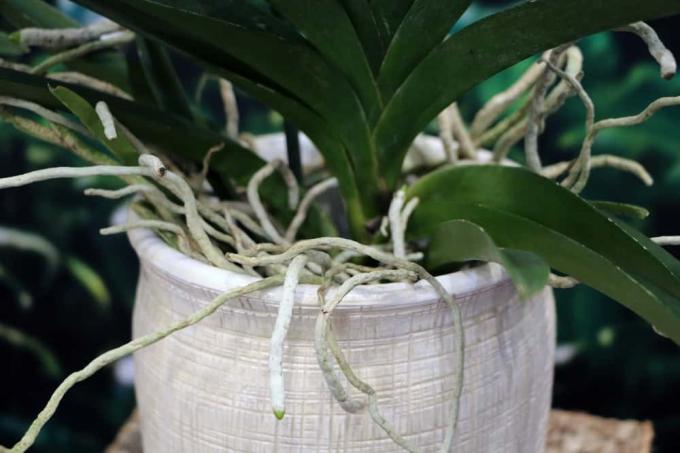
Table of contents
- change location
- Avoid cold drafts
- Prevent direct heating air
- compensate for lack of light
- Protect from the blazing midday sun
- Keep sufficient distance to fruit baskets
- Undo location change
- failures in care
- Fix water shortage
- increase humidity
- Replace substrate
- fight pests
- Conclusion
It happens without warning and leaves the hobby gardener concerned at a loss. The previously magnificent orchid flowers dry up and fall off. If that is not enough, buds that have already formed wither and are discarded. No orchid genus is exempt from this crisis, Phalaenopsis get caught in as well as Vanda or Cattleya. In this way, the exotic flower queens make it known that they do not like a circumstance at all. In view of this dilemma, you cannot avoid researching the causes. Read here what helps now!
change location
Subject the location of your orchid to a dedicated inspection, because here you can discover the main reasons for the shedding of the flowers. If you clarify the following points, the problem can already be solved:
Avoid cold drafts
What was a matter of course during the warm season becomes a problem in winter. If the location of your orchids is on a window sill that is regularly aired, cold air will penetrate in winter. If a room door is open at the same time, the tropical flower suffers a cold shock as a result of the draft. She reacts to this by shedding the flowers and buds.
Tip:
If you buy an orchid during the winter period, it is threatened with a cold shock on the way home. Ideally, a transparent box is available for transport. At the very least, the flower should be wrapped thickly in newspaper. Otherwise, the exotic treasure you have just acquired will be without any floral decorations within a few days.
Prevent direct heating air
A location in the direct influence of rising heating air causes the flowers on orchids to dry up and fall off. If the radiator in question cannot be turned off, move the plant. A decorative flower column in a light location, for example, serves as an ideal alternative place during the winter.
compensate for lack of light
In their tropical home, most orchid species thrive as epiphytes. In order to get as close to the light as possible, they hold on to the branches of treetops or rocks with their roots. The local light conditions from November to February therefore do not always meet the requirements. Since photosynthesis almost comes to a standstill under these circumstances, the flowers dry up and sadly fall to the ground. The same fate befalls already established buds. This helps:
- Put the orchid on the south window in winter
- Hang a daylight lamp or LED grow light over the flower
- Equip energy-saving lamps with reflectors to optimize light output
- Use fluorescent tubes for orchids of a similar height

While light and sun are scarce in winter, direct sunlight can pose problems during summer. If orchid blossoms are exposed to the blazing rays of the sun for a long time without protection, they age prematurely and fall off. Shading during the midday hours is therefore just as advisable on the balcony and terrace as it is on the windowsill or in the conservatory.
Keep sufficient distance to fruit baskets
Fruits that ripen later, such as apples and pears, give off the ripening gas ethylene. This also influences orchid blossoms if they are in close proximity to them. As a result, the aging process accelerates, the flowers dry up and are dropped prematurely. In this case, a distance of at least 1 meter will help to fix the problem.
Undo location change
If the misery only became apparent after a change of location, this itself can be the cause of the flower fall. Orchids are considered to be site-loyal plants that find moving stressful. Therefore, only relocate the flower queens if it is unavoidable or if one of the grievances explained above is a possible trigger. Otherwise, wait until the plant has acclimatized to its new location or revise the change of location.
failures in care
If a problem within the location topic could be ruled out as the cause, the focus of the investigations shifts to care. Put the following factors to the test:
Fix water shortage
When cultivating plants, drying flowers are an unmistakable signal of a lack of water. Orchids are no exception. If there are also slack, shriveling leaves, the damage actually indicates an unsuitable water balance. This is how the plant regains its balance:
- Never allow species and varieties without bulbs to dry out
- If in doubt, prescribe an immersion bath for the root ball
- The substrate should only dry before the next watering
- Orchids with bulbs are watered less frequently, but still regularly
Within the countless breeds there are considerable differences in terms of water supply. You should therefore ask an experienced specialist how to water your orchid correctly.
increase humidity
Maintaining adequate humidity levels goes hand in hand with water balance. If deficits also occur here – cumulatively resulting in a lack of water – the following measures will help:
- Fill the coaster with expanded clay and water
- The rising evaporation envelops the orchid flowers so that they do not dry out
- Ideally, spray daily with lukewarm, lime-free water
- Set up electronic humidifiers in the immediate vicinity
- In winter, put bowls filled with water on active radiators
Tip:
Take a look at the aerial roots to estimate the actual watering needs. If they are still green, there is sufficient moisture. Silvery shiny specimens indicate a lack of water.
Replace substrate
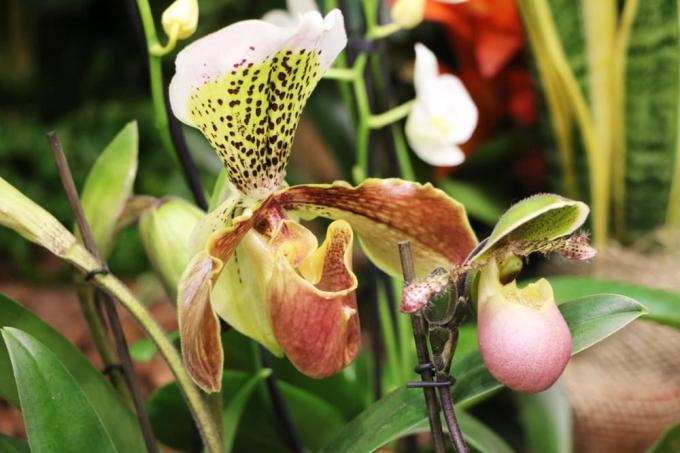
Within the broad orchid family, the vast majority develop aerial roots. Since the plants are epiphytes not rooted in soil, they take moisture and nutrients from the air. Anyone who imposes conventional potting soil on the exotic plants literally chokes off the air from the roots. This is especially true when a high amount of peat is involved. Irrespective of this, the trade offers orchids in such potting soil, so that the orchid flowers dry up because the roots can no longer provide the supply. What now helps is immediate repotting in a special substrate. Here's how to do it:
- Water the orchid a day or two beforehand and fertilize a little
- Unpot the plant without a strong draft
- If necessary, cut open the culture pot
- Remove the previous substrate as far as possible
- Cut out already suffering roots
- Create drainage from expanded clay in the pot
- Insert the orchid with a twisting motion
A mixture of pine bark, fine-grained humus, expanded clay or lava granules, some charcoal ash and sphagnum is suitable as a substrate. As you pour in the coarse soil in batches, tap the jar repeatedly on the floor or tabletop to ensure even distribution. The flower is watered after 5 days at the earliest. The next dose of fertilizer is given after 4 weeks.
Tip:
To ensure that there are no insect eggs or fungal spores in the substrate, it is sterilized. In a heat-resistant bowl, you can do this in the oven within 30 minutes at 180 degrees or in the microwave within 10 minutes at 800 watts.
fight pests
Their tropical origin does not protect orchids from infestation by native pests. Primarily sucking and biting species weaken the flowers to such an extent that they wither and fall off. How to deal with the parasites:
- Wipe aphids with a damp cloth
- Then spray the leaves and flowers with the well-known soft soap solution
- Swab mealybugs and mealybugs repeatedly with alcohol-soaked cotton swabs
- Alternatively, spray the leaves with a mix of 10 ml spirit, 1 liter of water and 1 drop of dish soap
- Treat both the top and bottom sides
In any case, the affected plant should be isolated so that the pests do not migrate to the neighbors. If the orchids are in a closed space, the Australian ladybird can be considered as a natural control agent. These are bred in specialist shops especially for this purpose and are delivered in suitable containers.
Conclusion
When orchid flowers dry up and fall off, there is no reason to lose heart. Instead, look for the cause in order to take appropriate countermeasures. Problems at the current location may have triggered the misery. What helps now: avoiding cold drafts, preventing direct heating air, remedying a lack of light, protecting against the blazing midday sun or avoiding the immediate vicinity of a fruit basket. In addition, failures in caregiving can create the problem. If the substrate is too dry or the humidity is too low, it is easy to compensate. If there is waterlogging behind it or compacted substrate, immediate repotting is an option. Last but not least, there are pests such as aphids, mealybugs and mealybugs that affect an orchid in such a way that it sheds its flowers.
 garden editorial
garden editorial I write about everything that interests me in my garden.
Learn more about orchid species
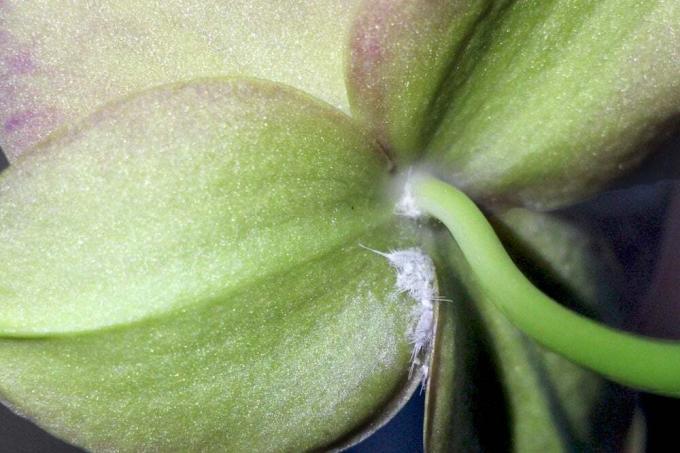
Fight pests on orchids - ways against lice & vermin
Orchids are popular indoor plants and are often given as gifts, but unfortunately they are also occasionally attacked by pests - and these can cause considerable damage to the plants. Interested parties can find out here how pests on orchids can be combated.
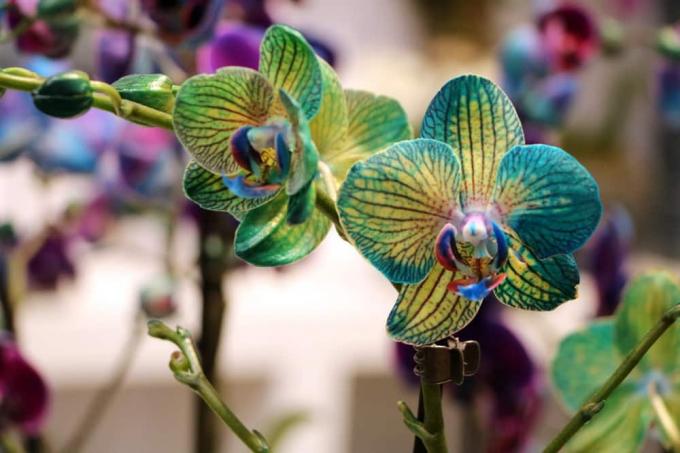
Blue orchids: how to dye orchids blue yourself
If orchids with blue flowers are offered in the garden trade, they are usually not natural flower colors. With a bit of skill, you can also dye white-flowering orchids yourself if you repeat the process for each new bloom.

Cypripedium Orchids - Caring for Hardy Lady's Slippers
The exotic plant is a real eye-catcher and, with its unusual flowers, provides the extravagant touch in the home garden. However, if you want to enjoy the beautiful flowers from May, you need a little finesse when it comes to care.

Orchid has withered leaves - this is how you get them fit again
A healthy orchid usually has few but fleshy and lush green leaves. When they start to wither, the shock is great at first. Can the orchid still be saved? Read what your orchid is missing and what you can do about it.

Orchid location above the heating - is heating air harmful?
Many orchid species are native to subtropical and tropical climates. They need light, warmth - and high humidity. Conditions that do not exist in winter and in a place above a heater. With these measures, you can still get your orchids healthy through the cold season.
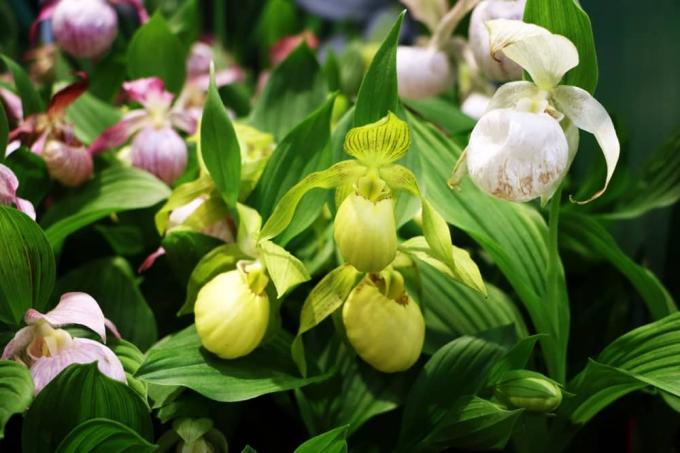
Native orchids: 8 wild varieties in the garden and forest
No way orchids only thrive in the tropics! They even exist in Antarctica - and of course here too. In fact, a wide range of wild orchid plants can be found in our forests and gardens. Learn more here.
